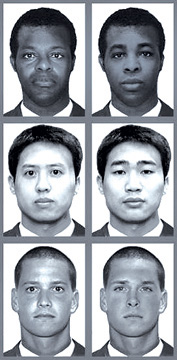The line "They all look alike to me" may sound offensive, but to people raised in racially homogenous settings it's often the simple truth. Distinguishing facial features in people of unfamiliar races is a learned skill, honed more through exposure than noble thinking.

The study, whose results were published in January in PLoS ONE , the peer-reviewed online journal of the Public Library of Science, was coauthored by Sophie Lebrecht, a third-year doctoral candidate in cognitive science, and Michael Tarr, a cognitive neuroscience professor who codirects Brown's Center for Vision Research.
"The idea," Tarr says, "was that if you can't tell people apart, maybe you stereotype them." The pair teamed up with facial-recognition researchers at the University of Victoria, who assembled twenty Caucasian subjects. "On Victoria Island, there are very few African American faces," Tarr explains, which made it easy to find people with little past exposure to them.
Lebrecht devised a test—the Affective Lexical Priming Score (ALPS)—to measure how fast the subjects made various word associations after looking at African American and Caucasian faces. The subjects made quicker negative word associations after seeing black faces and quicker positive associations after looking at white faces.
Following the initial testing, subjects received ten hours of facial-recognition training. Some were trained to categorize people by race, and others to distinguish among individual African American faces. The portraits, all in black-and-white, showed people with similar hair and face shape, which encouraged close observation of facial features rather than a more generalized perception of race.
Then the subjects were retested. Those who focused on individual facial characteristics had more favorable ALPS scores the second time around.
Tarr cautions that this one study does not prove that racial bias can be significantly reduced through facial-recognition training. But he does believe the practice could help sensitize people—police officers, for instance—whose jobs require them to see people of other races as individuals and not simply as representatives of a racial group.
"The remarkable thing," he says, "is that just ten hours of training accomplished so much."





